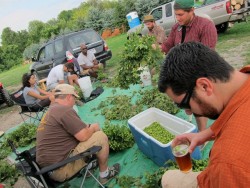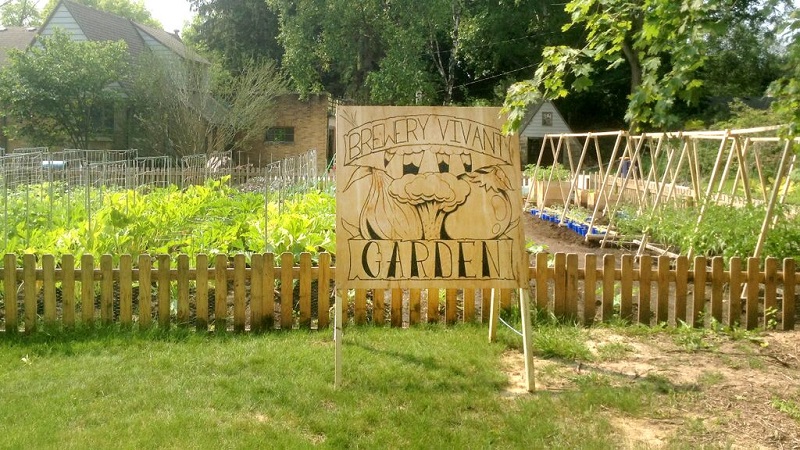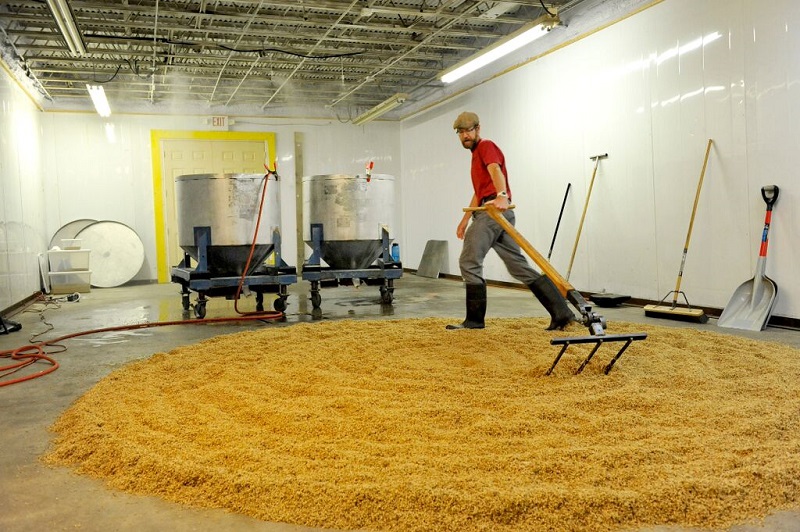Creating a ‘Beer From Here’

Regulator Brewing, a nanobrewery planning to open in Hillsborough, North Carolina, sources hops, malt and other ingredients from local growers.
There’s a 50-pound bag of two-row pale malt sitting on the concrete floor of Regulator Brewing’s brewery space. A small amount of text on its front states its contents, but it also may read like something of a map and business plan in one.
Grown, malted and packaged about 30 miles to the south of the Hillsborough, NC, brewery, the malt doesn’t just represent the promise of fermentable sugars and the beginning of a hazelnut brown ale, but also the belief that a beer can—and should—be about a place.
Brewed as a test batch for its small one-barrel system, the ale is Regulator’s attempt to produce a “beer from here” by using no less than 75 percent local ingredients in each batch, whether that’s grain, hops, wheat, vegetables or more. To source recipes, Regulator members visit farmers within an hour’s drive and frequent the Eno River Farmers Market in downtown Hillsborough.
“We want to make beer from our community, using local ingredients to feel a sense of ownership of where we live,” said Stephanie Williams, one of four partners planning to open Regulator Brewing this spring. “We know we’ll be proud of it because we couldn’t think of a better way to be a part of our local economy.”
Much like the farm-to-table movement that has spurred interest in locally produced foods and an explosion in farmers markets across the country, the beer industry is also seeing a growing connection between breweries and local agriculture.

Peak Organic Brewing in Portland, Maine sources ingredients from local hop and grain farms. (Photo courtesy Peak Organic Brewing)
As the number of breweries has skyrocketed in recent years, so, too, have the farmland, crops and people that support it. Farm supporting breweries include, to name a few, Fullsteam Brewery in North Carolina, Peak Organic in Maine, Lakefront Brewery in Wisconsin, Good Nature Brewing in New York, and Black Hog Brewing in Connecticut.
In its last report on the economic impact of the beer industry on agriculture, a 2012 survey by the Beer Institute trade association showed breweries helped create 55,900 jobs in agriculture nationwide and added $5.5 billion in economic output that year. Andrea Stanley, owner and maltster with Hadley, MA-based Valley Malt, noted those numbers have great potential to grow.
“Brewers are finding smaller producers, and smaller farmers are willing to grow more unique types of grains that can open up the palette of colors of what they’re able to brew with,” said Stanley, president of the North American Craft Maltsters Guild. “Most of us open our businesses because we see an opportunity and trend of people wanting to support local, and we’re filling a unique gap in the supply chain for breweries.”
In North Carolina, Regulator’s local source of grain, Farm Boy Farms of Pittsboro, NC, has seen its acreage of barley grow more than six times its original planting space, from 7 acres in 2010 to 44 in 2014. Over that time span, owner Dan Gridley has moved from malting batches of 50 pounds up to 1,000. He’s now done business with more than 20 in-state breweries, and the number of Gridley’s hop plants went from 20 to 300 in the last four years.
He’s not alone.
According to the Hop Growers of America, three states—Idaho, Washington and Oregon—accounted for 31,289 acres of hops strung for harvest in 2010. In its mid-year 2014 report, 39,272 acres were strung across the country, with 14 more states joining the mix. That included plantings as small as 8 acres in Indiana, up to 300 in Michigan.
“With new hop growers entering the market every year, we won’t plant anything that we don’t have under contract anymore,” said Brian Tennis, owner of Michigan Hop Alliance, an independent group of about a dozen farmers from the Mitten State. “Smaller accounts are starting to have a big presence with us, too.”
That’s helped push Tennis’ business, which started with just 1 acre of his own hops in 2007 and is now up to 15 of his own with an additional 40 from farmers across the state. He expects Hop Alliance membership to potentially double in 2015 to about 25 farmers.
With changing tastes and expectations for what goes into beer, Tennis has worked to find niche markets for his hops, which includes experimenting with growing Sorachi Ace, Tardif de Bourgogne and other foreign hops in Michigan’s climate.
With increased interest in organic goods by both consumers and breweries, Tennis has also focused on selling certified organic hops to Michigan businesses like Short’s Brewing Co., Grand Rapids Brewing and Brewery Vivant, which buy organic Chinook and Summit hops from the Michigan Hop Alliance. Vivant also homes in on other ingredients from local farms, including honey, maple syrup and fruit juices.
“We think everyone should support family farms because supporting your local economy is the right thing to do,” said Kris Spaulding, co-owner of Brewery Vivant, which has a goal of sourcing 25 percent of beer ingredients from within 250 miles. “Our commitment benefits our immediate community, and we hope it also influences the customer to expect that from their beer.”

Brewery Vivant aims to source 25 percent of its ingredients from within 250 miles of its brewery in Grand Rapids, Michigan.
The growing sentiment of “local” and its importance to consumers has readily gained steam in industries outside just food and handcrafted goods, said Sara Day Evans, founder and executive director of Accelerating Appalachia, a nature-based business accelerator geared toward helping growing businesses from around the globe with a focus on the East Coast’s Appalachian region. One of the companies supported in its 2013-2014 business development program was Riverbend Malt House in Asheville, NC, which Evans noted is following the trend of offering locally sourced products for the beer industry.
“At its core, I think we’re regaining a sense of humanity in our consumer choices and even neighborliness to one another,” Evans said. “There’s a great deal of satisfaction people gain from supporting their community and small businesses at a time when we’ve made it easy to detach from that. I’m seeing more people crave a real connection to a sense of place, even through beer. It’s kind of a homecoming for our local economies.”
Which is exactly what the founders of Regulator Brewing hope they see when they begin selling their beer, including a seasonal pepper basil pale ale that features 95 percent locally grown ingredients.
“One of the things we’ve always loved about Hillsborough is how local customers and businesses support one another, which is how you build a truly local economy,” said co-founder Dustin Williams. “I love that we can drive down the road, pick up a sack of freshly malted grain and brew the next day. This isn’t a way of life that’s personal for us; it’s a chance to support small farmers and preserve our agricultural heritage.”


Leave a Reply